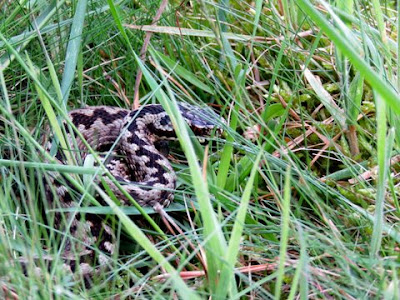SMALL HEATH
Its a funny old past time, birdwatching. Its not to everyone's taste, and it can seem a bit too esoteric to appeal to any but a small number of people. But it can also be a fascinating hobby and a way to unwind from the modern world, a way to find some breathing space. I mention this as I attended a birding walk this morning, an organised workshop on bird song. It was run by Steve Piotrowski and John Grant probably the two biggest names in Suffolk birdwatching, semi legends in their own right. Under their vast bird watching knowledge we had a great morning's bird watching walking areas of Suffolk that were new to me. It was based around the Froize, a pub restaurant in Chillesford, probably serving the best food in the area, even for a veggie like myself, where we had a lunch at the end of the event.
WOODLARK perched atop a conifer, a way it differs form the skylark
We started with coffee at the Froize where we met up, around eight o'clock. There were around ten people in the group, which is a reasonable number for a birding trip. From the Froize we moved onto Bromeswell, just north of Melton and Woodbridge. This is a small wildlife trust nature reserve, which has some woodland surrounding a couple of fen meadows. NIGHTINGALES were what we were looking for, the morning was built up around them, and as soon as we got out of the car we were hit by the 'machine-gun' fire by one. We heard more as we looked around eventually getting a view of the elusive bird. This is a species that is undergoing a massive decline, due to habitat destruction here, linked to deer eating the understorey of woodland, and habitat destruction in Africa, where they winter.There were plenty of other singers, mostly common birds but also included a GARDEN WARBLER, which I have trouble differentiating its song from blackcap's.
After we had walked around Bromeswell, we changed location and moved onto Hollesley Common. This is a large and beautiful area of heath, well managed, a dynamic and shifting environment where different habitats merge into each other, like a living painting. Areas of heather with scattered pines morphed into woods, or into grassland where the emerging SHEEP'S SORREL burned the ground a deep red.
SHEEP'S SORREL turned the grassy areas of the heath a deep red
Its always interesting to see how other people bird watch, and Steve and John had a different approach to myself. There's was more methodical, slower, looking at every bird, whilst I usually just walk as quickly as possible through an area, only stopping when I see something unusual. Their approach seemed the best at seeing the birds and there was some cracking birds to see at Holleslley.With heathland it is the scarce birds that are the attraction, and the area proved to be particulalrly rich in the birds associated with this environment. There were lots of WOODLARKS around, the numbers seen getting into double figures, which is good for a scarce bird. We would often disturbed them from the ground and they would fly up a few metres, perch in a tree or go back to ground. They were often seen in song flight, like the closely related skylark's but with a much different song. One was perched on a fence post singing its heart out. It just shows that with a decent amount of the right habitat any species can be quite common. SKYLARKS were also seen but singing over the surrounding farmland, birds of a different habitat.
ADDER found amongst the tall grass
Also on the heath was a herd of maybe thirty FALLOW DEER seen in all manner of colours including several white ones, they make light work of getting over the surrounding fences. Another denizen of the heath was a male STONECHAT, as usual perched up on a gorse bush, and another species less restricted to heath, the YELLOWHAMMER, were seen with some singing perched visibly on gorse bushes.
Reptiles are often associated with heaths and a small ADDER was spotted sunning itself before slithering off after getting some unasked for attention.
After we had walked the heath we changed car parks, to one literally just down the road. In this car park a puddle existed, which we had a look at maybe in the distant possiblity of seeing CROSSBILLS drinking from it. We saw a COAL TIT drinking, but no crossbills. However seeing a small bird fly onto a little birch sapling I focused on it and seeing an unmistakable red and black plumage identified it as a male REDSTART. They are an absolutely beautiful bird with a red chest and a silvery grey back. This bird was carrying food and was obviously feeding young in the area. The bird kept moving to various posts in the area giving some cracking views. Definitely the bird of the day. This bird is now a very rare nesting bird in Suffolk, which is a shame as it looks so great, its population has gradually dwindled, facing the same pressure as all our summer visitors.
That ended the morning's bird watching, and having worked up a hunger we headed back to the Froize and had a well deserved lunch. Thank you very much.
So a good morning's birding. Its nice to finally meet some of the big names in Suffolk bird watching, to get some access to their local knowledge. They were both thoroughly decent people, engaging, and very happy to dispense some of their experience. It was nice to see some new areas of land, to open up places and to see some cracking species. I have another walk in June - about nightjars - and I'm looking forward to attending it. Worth a look if you're interested in birds, and want to learn more from some local experts.




No comments:
Post a Comment